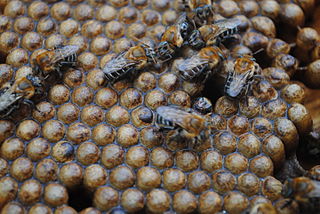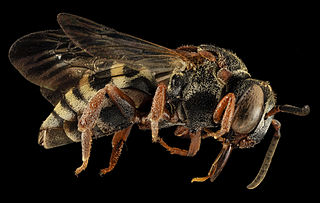
Omorgus scutellaris is a beetle of the family Trogidae. It is found in the United States and Mexico.
Amblyptilia scutellaris is a moth of the family Pterophoridae that is known from Colombia.
Aedes scutellaris is a mosquito found in Ambon, Aru Islands, Seram, New Guinea. It is a vector for the dengue virus.

Tachys scutellaris is a very small ground beetle found in salt marshes.

Crematogaster scutellaris is a species of ant belonging to the family Formicidae, subfamily Myrmicinae.
Brachygastra scutellaris, a honey wasp, is a Neotropical, swarm-founding species that is found in South America and has a medium-sized population of 100–1000 individuals per colony. It stores large amounts of nectar in its nest for the production of honey, and it was even found that at certain times of the year, the nectar is toxic to humans, as they will extract nectar from hallucinogenic plants, depending on the season.

Parastesilea is a genus of longhorn beetles of the subfamily Lamiinae, containing the following species:

Melipona scutellaris is a eusocial stingless bee species of the order Hymenoptera and the genus Melipona. It is considered to be the reared Melipona species with the largest distribution in the North and Northeast regions of Brazil, with records from Rio Grande do Norte down to Bahia. Its common name, Uruçu, comes from the Tupi "eiru su", which in this indigenous language means "big bee". Their honey is highly desirable and the materials they create for nests have been proven to be a promising source of antibiofilm agents and to present selectivity against human cancer cell lines at low concentrations compared to normal cells.

Chrysis scutellaris is a species of cuckoo wasps.

Brachychilus scutellaris is a species of beetle in the family Cerambycidae. It was described by Blanchard in 1851. It is known from Chile and Argentina. It contains the varietas Brachychilus scutellaris var. irroratus.
Parastesilea latefasciata is a species of beetle in the family Cerambycidae. It was described by Stephan von Breuning in 1938, originally under the genus Stesilea.

Epeolus scutellaris is a species of cuckoo bee in the family Apidae. It is found in the United States and Mexico.

Zeugophora scutellaris, known generally as the poplar blackmine beetle or cottonwood leaf-mining beetle, is a species of megalopodid leaf beetle in the family Megalopodidae. It is found in Europe and Northern Asia and North America.

Chauliognathus scutellaris, the Texas soldier beetle, is a species of soldier beetle in the family Cantharidae. It is found in Central America and North America.
Euparagia scutellaris is a species of wasp in the family Vespidae. It is found in the western United States, and larvae feed on weevil larvae.
Calliopsis scutellaris is a species of bee in the family Andrenidae. It is found in Central America and North America.

Cicindela scutellaris, the festive tiger beetle, is a species of flashy tiger beetle in the family Cicindelidae. It is found in North America.
Paria scutellaris is a species of leaf beetle. It is found in North America.
Orthoperus scutellaris is a species of minute hooded beetle in the family Corylophidae. It is found in North America.

Callidiopis scutellaris, the round-headed wood borer, is a native Australian beetle now also present in New Zealand.












